Bush Hog Disk: Essential Tool for Modern Agriculture
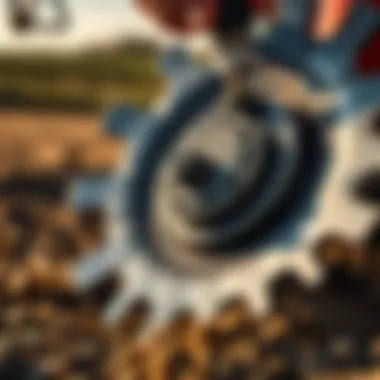

Intro
In the vast and ever-evolving world of agriculture, implements like the bush hog disk emerge as crucial tools that foster productivity and sustainability. Farmers lean on such equipment to prepare land, manage crops, and cultivate the rich soil that sustains our food systems. Understanding the bush hog disk is essential, not just for the experienced farmer but also for newcomers aiming to harness the power of effective agriculture.
The bush hog disk combines simple mechanics with a wealth of design thought, making it a favorite among farmers and land managers. They are widely recognized for their ability to improve soil health by breaking up compacted dirt and promoting better water absorption. This is not just another farming tool; it represents a convergence of tradition and modern agricultural practices that can strengthen the bond between land and farmer.
As we delve deeper into this exploration, we will uncover the significant features of the bush hog disk, discuss its practical applications, and consider its role in sustainable farming practices. A fair bit of wisdom can be gleaned from both the old hands and the fresher faces in the field, and capturing that knowledge is what makes this topic so engaging. Let's kick this off by diving into some key insights.
Prelims to the Bush Hog Disk
The Bush Hog disk stands as a quintessential tool in the arsenal of agricultural implements, valued not just for its capability to prepare the land but for the wider impact it has on farming productivity. In a landscape where efficiency and effectiveness dictate the success of farming operations, understanding this equipment’s role is paramount. As we explore this section, we delve into the definition and history of the Bush Hog disk, forging connections between past practices and modern applications in agriculture.
Definition and Purpose
At its core, the Bush Hog disk is an implement used primarily for tilling the soil. It consists of a series of sharp blades affixed to a strong frame, designed to cut through the ground and break it apart. This mechanical cultivator is crucial for land preparation, providing farmers with the tools needed to enhance soil structure and promote robust crop growth. The purpose of the Bush Hog disk extends well beyond basic tilling; it aids in weed control, soil aeration, and the incorporation of organic matter into the soil, creating a fertile base for planting.
Moreover, the precision with which these disks can operate also means farmers can cater to varying soil types and conditions. Whether you are working with heavy clay or loamy soils, there's likely a Bush Hog disk tailored to fit those needs. Importantly, understanding its many functionalities allows farmers to maximize their investment, ensuring they get every ounce of usage out of the implement.
"Efficient tilling can often be the difference between a good harvest and a bumper crop."
Historical Context
The roots of the Bush Hog disk trace back to early agricultural practices when manual tilling was labor-intensive and time-consuming. Farmers relied on horse-drawn plows and crude blades until the mechanical revolution brought changes in the late 19th century. The introduction of tractors and more sophisticated machinery led to the development of what we now consider modern farming equipment.
Bush Hog, as a brand, emerged in the mid-20th century, noted for its commitment to durable and efficient agricultural machinery. The advent of the Bush Hog disk transformed land management practices by providing a reliable alternative to traditional methods. Its design continued to evolve, refining its utility from basic plowing to encompassing a broader spectrum of soil movement and preparation tasks.
One cannot underestimate how historical advancements in technology not only influenced this implement's functionality but also shaped the agricultural landscape we see today. The Bush Hog disk underscores a journey of adaptation, pushing the envelope on how farmers approach their daily operations and ensuring their methods stand the test of time.
Understanding the Mechanics
Understanding the mechanics of the Bush Hog disk is vital for farmers and agricultural enthusiasts alike. This section lays bare the intricate workings of this implement, focusing on various fundamental components that ensure efficient land management and tillage. Knowing how every part functions not only enhances productivity but also extends the lifespan of the disk. Let’s dive into the key components that make this tool a linchpin in modern agriculture.
Key Components of Bush Hog Disks
Blades
The blades are arguably the most crucial part of a Bush Hog disk. They are typically constructed from high-carbon steel, designed to withstand the rigors of soil contact. One of their defining characteristics is their sharpness. The sharp blades cut through soil and vegetation, creating a tilled surface that promotes healthy crop growth. A remarkable feature of these blades is that they can be either smooth or notched, with the latter offering increased dragging action, making them a favorable choice for heavier, tougher soils. However, the trade-off is that notched blades suffer from quicker wear compared to smooth ones. The efficiency of the blades directly affects the overall performance of the disk, making it essential for farmers to choose wisely based on their soil type and agricultural goals.
Frame
Next in line is the frame of the Bush Hog disk. This component serves as the backbone of the implement, designed to provide structural support for all other parts. Typically made from heavy-duty steel, the frame must withstand harsh working conditions as it endures pressure and impacts from both the terrain and the operating environment. A key characteristic of the frame is its weight distribution; a well-designed frame ensures that weight is evenly spread, which enables better soil penetration and prevents bounce during operation. One unique feature is that some frames are adjustable, allowing farmers to modify the angle of the disk blades for different soil conditions. This adaptability can offer significant advantages, but farmers must keep in mind that too much adjustment can lead to reduced performance if not done correctly.
Attachment Mechanisms
Attachment mechanisms hold everything together, allowing the Bush Hog disk to connect seamlessly with tractors or other farming equipment. These mechanisms must be robust and simple to operate, ensuring that the disk remains secure during tillage operations. The most prevalent attachment type in use is the pin-style mechanism, which allows for swift changes in connection and disconnection, thus enabling multi-tasking in the field. A noteworthy feature is that many modern attachment systems are designed with user-friendliness in mind, featuring quick couplings that make it easy to switch between implements without heavy lifting. However, one disadvantage is that frequent attachments can lead to wear over time, necessitating regular checks for optimal function.
How It Operates
The operation of a Bush Hog disk combines the efforts of its individual components, bringing them together to achieve effective land preparation. The blades slice through the dirt, turning and loosening it, while the frame maintains stability and strength during the process. As the farmer navigates the equipment across the field, the attachment mechanisms ensure that everything remains secure, allowing for a smooth and efficient workflow. Understanding how these elements function as a cohesive unit is critical for optimizing fieldwork.
"A well-maintained Bush Hog disk not only saves time but also enhances soil health, ultimately leading to better crops."
With this foundational knowledge, farmers are equipped to utilize the Bush Hog disk to its fullest potential.
Types of Bush Hog Disks
Understanding the various types of Bush Hog disks is essential for farmers who want to make informed decisions about the right equipment for their land management and cultivation needs. Each type serves distinct purposes and offers unique benefits, making it crucial to grasp their specifics. The right choice can greatly enhance efficiency and productivity while ensuring that the land is managed effectively.
Standard Disks
Standard disks are the bread and butter of many agricultural implements. They are typically designed for general use and are suitable for a variety of tasks, from initial tillage to seedbed preparation. These disks often feature a singular blade size that ensures consistent performance across varying soil conditions.
- Versatility: Standard disks can adapt to different farming styles and conditions, which makes them a popular choice among small to medium-scale farmers.
- Ease of Operation: Many operators find standard disks straightforward to use, making them a good choice for those who aren't looking for anything overly complicated.
- Maintenance-Friendly: With fewer parts compared to specialized models, standard disks tend to be easier to maintain, helping you keep downtime to a minimum.
Due to these factors, standard disks become an ideal investment for both new and seasoned farmers who may not require complex features but still demand reliable performance.
Heavy-Duty Models
For farmers facing challenging conditions, heavy-duty models stand out as robust options capable of tackling tougher terrains and crop residue. These disks are generally constructed with higher-grade materials and are designed for more intensive applications.
Some key features include:
- Increased Weight: The added weight helps these disks penetrate tough soil and manage heavier stubble, breaking down materials more effectively than lighter options.
- Advanced Durability: Heavy-duty models are built to withstand rigorous use, which means fewer replacements and repairs over time.
- Efficiency in Hard Soil: These disks excel in compacted soils, making them indispensable for farmers operating in areas with clay or rocky ground.
Farmers are likely to see improved operational efficiency through the enhanced capabilities of heavy-duty models, allowing for better yields and improved soil structure.
Adjustable Options
Adjustable disks bring a level of flexibility that can be a game-changer in agricultural practices. These disks allow operators to modify the angle and depth, adapting quickly to varying soil types and cultivating requirements.
Consider these benefits:
- Personalization: Operators can fine-tune settings for different usages on the go, whether preparing a seedbed or managing a cover crop.
- Soil Health: The ability to control the depth of tilling can lead to better soil aeration and moisture retention, promoting overall soil health.
- Economic Efficiency: Farmers can transition from one task to another without needing multiple implements, thus saving time and reducing operational costs.
Adjustable options can be particularly advantageous for farmers managing diverse crops or transitioning through different seasons, where flexibility is paramount.
In summary, recognizing the unique characteristics of standard, heavy-duty, and adjustable Bush Hog disks equips farmers with the knowledge needed to select the right type for their specific needs.
For those interested in exploring further, additional resources can be found at Wikipedia, Britannica, and Reddit.
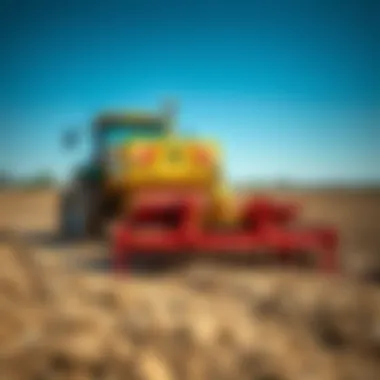
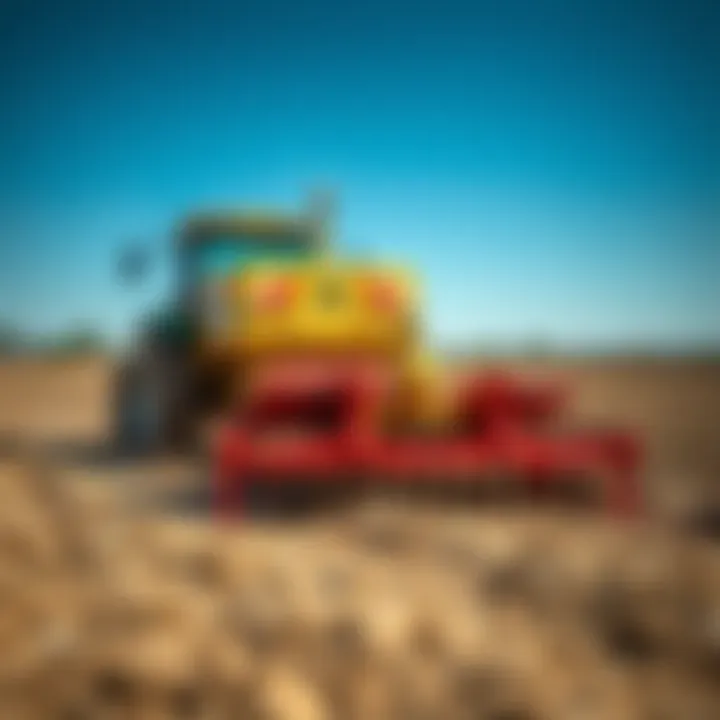
Applications in Agriculture
The applications of a Bush Hog disk are vast and play a crucial role in various agricultural practices. This implement is not merely a tool; it serves as a backbone in ensuring the efficiency and productivity of farming operations. By breaking down the land into more precise segments, the Bush Hog disk allows farmers to optimize their workflow, leading to higher yields. In this section, we’ll dive into three significant applications that highlight its importance: land preparation, weed control, and soil aeration.
Land Preparation
Land preparation is fundamentally about setting the stage for a successful planting season. Utilizing the Bush Hog disk in this process provides multiple advantages. First off, it effectively breaks up the soil, providing a conducive environment for seedlings. This results in improved seed-to-soil contact, which can be critical for germination.
When tackling land preparation, the bush hog disk cuts through hardpan layers and loosens compact soil, setting up an ideal seedbed. Without adequate preparation, you might as well be planting seeds in concrete. Here are some essential steps where the Bush Hog disk shines:
- Breaking Up Soil Clumps: Instead of relying solely on plowing, this disk can help pulverize clods, allowing for finer soil texture.
- Creating Furrows: For row crops, establishing consistent furrows promotes better irrigation and even seed distribution.
- Mixing Organic Matter: Whether you’re incorporating cover crops or organic fertilizers, the Bush Hog can blend these elements into the soil seamlessly.
Weed Control
Weed control consumes a significant amount of resources for farmers. Effective management requires both time and labor, but a Bush Hog disk can substantially reduce these burdens. By tackling weeds early in the crop cycle, the disk can help minimize competition for nutrients between crops and unwanted plants.
Employing the Bush Hog disk for this purpose involves cutting weeds before they go to seed. With its sharp blades, this disk works its magic under the surface, unsettling weed roots. Consider these benefits:
- Preventing Seed Germination: The disturbance caused by disk tillage can inhibit the germination of weed seeds lying dormant in the soil.
- Enhanced Crop Growth: By eliminating competing vegetation, crops get more light, water, and nutrients, leading to better growth.
- Cost-Efficiency: Investing time with a Bush Hog disk today can save significant funds down the line by reducing herbicide needs.
Soil Aeration
Aerating the soil is just as important as preparing the land and controlling weeds. Proper aeration encourages better root development, water infiltration, and microbial activity. A Bush Hog disk creates natural channels in the earth, allowing life-sustaining air to reach the root systems of crops.
Regular use of the disk for aeration can prevent compaction, which is a common problem in heavily trafficked fields. It helps maintain soil health and fertility by promoting:
- Improved Drainage: Well-aerated soil drains more effectively, reducing waterlogging, which can suffocate roots.
- Stimulated Microbial Activity: Beneficial microbes thrive in aerated soil, enhancing nutrient cycling crucial for crop health.
- Better Moisture Retention: Interestingly enough, a well-aerated soil retains moisture more efficiently, yielding benefits during dry spells.
"A well-aerated and prepared field is the lifeblood of any successful crop. The Bush Hog disk is worth its weight in gold when it comes to achieving this."
For more insights into agricultural practices and technologies, you might find the resources at Britannica or discussions on Reddit Agriculture helpful.
Benefits of Using a Bush Hog Disk
The use of a Bush Hog disk provides numerous advantages that enhance agricultural efficiency and productivity. Understanding these benefits is essential for farmers and land managers looking to cultivate land more effectively. From operational efficiency to environmental sustainability, each aspect plays a pivotal role in contemporary farming practices. Here’s a deeper dive into these benefits:
Efficiency in Operations
The design of the Bush Hog disk focuses on maximizing operational speed and efficiency. Farmers can cover large areas in a shorter time, which leaves more hours in the day for other important tasks.
"Time is money, especially in agriculture."
Using these disks, a farmer can till fields with consistent and even soil penetration, which lowers the chance of missing patches. The agility and versatility are also noteworthy. Whether tackling new, unbroken land or rejuvenating older fields, the Bush Hog disk adapts well, maintaining high operational throughput. This means a farmer can complete their tillage work quicker, which directly translates to getting crops in the ground on time, leading to better yields.
In addition, the effective cutting and churning of the soil can help with weed suppression without the need for more frequent herbicide application. Less reliance on chemicals streamlines operations and cuts down labor time, allowing farmers to allocate resources more efficiently.
Cost-Effectiveness
Investing in a Bush Hog disk can yield significant cost savings over time. To begin with, the durable construction of these implements ensures they endure wear and tear, reducing the frequency of replacements. A farmer can view this purchase as a long-term investment instead of a fleeting expense.
Moreover, through its efficiency, a Bush Hog disk reduces operational costs associated with fuel and labor. Farmers often find that using the disk allows them to get more done with less fuel, decreasing their overall energy expenses. This efficiency doesn’t just benefit the farmers’ wallets; it also positively affects productivity in relation to time spent in the field.
Lastly, by promoting healthier soils through consistent aeration and tillage, a Bush Hog disk indirectly contributes to soil productivity, which can lead to more robust crop outputs and better revenue generation in the long run. The approach aligns financial benefits with improved land use, creating a compelling case for its adoption.
Sustainability Contributions
Sustainability is a crucial consideration in modern agriculture, and the Bush Hog disk supports this paradigm in numerous ways. At its core, this implement fosters better soil health. As the disk aerates soil and breaks up clumps, it promotes better water infiltration and retention. Healthy soil structure is key to agricultural sustainability, ensuring the land remains fertile and robust for future generations.
Beyond soil health, practicing responsible tillage with a Bush Hog disk limits soil erosion, an ongoing challenge in farming. As the disk allows for effective tillage without creating excessive loose soil on the surface, the risk of runoff decreases. This contributes to minimizing the environmental footprint of farming practices.
Furthermore, integrating conservation tillage techniques with the disk can improve carbon capture, supporting broader sustainability goals in agriculture. Moreover, with farmers increasingly pushed to adopt environmentally responsible practices, the Bush Hog disk positions them as proactive participants in the movement toward sustainable agriculture.
In summary, utilizing a Bush Hog disk provides clear benefits ranging from operational efficiency and cost savings to sustainable agricultural practices. The implement stands as a testament to how suitable tooling in farming can streamline processes, reduce expenses, and contribute positively to the ecosystem.
Best Practices for Usage
Using a Bush Hog Disk efficiently starts well before one sets out to tackle the fields. Implementing best practices not only saves time and money, but it can also enhance the crop yield significantly. Here’s a closer look at essential aspects to keep in mind when using this piece of equipment.
Pre-Operational Checks
Before cranking up the engine and heading out, performing pre-operational checks is crucial. This process ensures that the Bush Hog Disk is ready to roll without a hitch. Here are key items to verify:
- Fluid Levels: Make sure oil, hydraulic fluid, and coolant are at the appropriate levels. Low fluids can cause unforeseen breakdowns or inefficient performance.
- Blades: Inspect the blades for signs of wear or damage. Dull blades can ruin your groundwork, as they won’t cut effectively, leading to uneven soil preparation.
- Tires and Hitch: Check the tire pressure and condition, along with the hitching mechanism. Tires that are properly inflated can impact maneuverability greatly, while a solid hitch ensures safety and stability during operation.
- Safety Equipment: Ensure that all safety guards and covers are in place. Safety mustn’t take a backseat when farming, as unprotected machinery can lead to serious accidents.
Remember, it’s always cheaper in the long run to catch a small issue before it escalates into a major repair.
Optimal Settings
Setting the Bush Hog Disk correctly for the specific field conditions can make or break the efficiency of your operation. Here are some points to consider for optimal settings:
- Depth Adjustment: Depending on soil types and conditions, adjust the disk’s operating depth. Deeper cuts may be necessary for tougher soil, but they come at the cost of increased fuel consumption.
- Angle of the Blades: The angle of the blades can alter how aggressively the disk engages with the soil. A sharper angle can cut down more effectively, but might also lead to soil compaction if not managed properly. Adjust based on the desired result.
- Speed of Operation: Slower speeds allow for a thorough job, while high speeds may lead to incomplete tilling. Finding that sweet spot is essential for maximizing both efficiency and effectiveness.
- Weight Distribution: Ensure that weight is evenly distributed across the implement. Uneven weight can result in poor performance and uneven soil preparation.
Field Navigation Tips
Navigating the fields isn’t just about following straight lines. Proper techniques can minimize soil disruption and enhance overall efficiency:
- Plan Your Path: Before starting, outline a clear plan for your passes through the field. This can save time and prevent overlapping—thus avoiding unnecessary soil disturbance.
- Use Landmarks: Identify natural landmarks to guide your movements. Familiarity with the field will help you stay oriented and keep operations running smoothly.
- Monitor Crop Lines: If tilling between existing crops, pay close attention to crop lines to avoid damaging plants. Sometimes, a little finesse is required to maintain the health of standing crops.
- Adjust as Needed: Be prepared to adjust your navigation based on soil conditions or obstacles. Flexibility can make a world of difference in successfully navigating tricky terrain.
In the farm life, it’s the little things that count. Implementing best practices for using the Bush Hog Disk can really up your agricultural game.
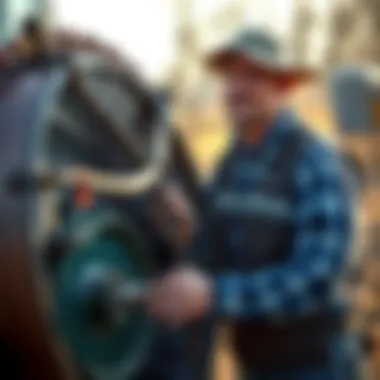
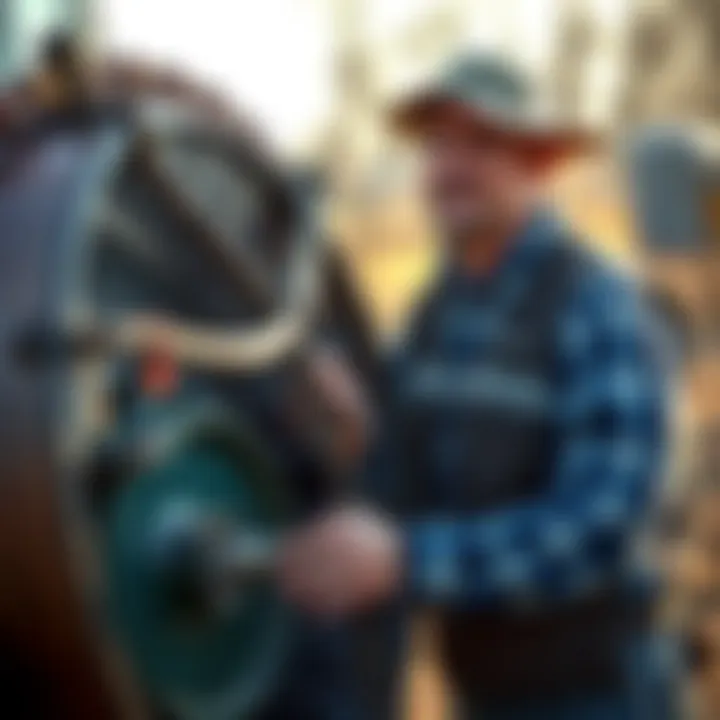
Maintenance Considerations
Maintenance of a Bush Hog disk is crucial for its longevity and performance. Taking care of this essential implement not only ensures better efficiency but also saves costs in the long run. A well-maintained disk can transform a farmer's experience in the field, offering precision and ease in operations. Neglecting maintenance can lead to costly repairs and downtime, which is something that any diligent farmer would want to avoid. Regular upkeep allows farmers to maximize the value they get from their investments.
Regular Inspections
One of the foundational aspects of maintaining a Bush Hog disk is conducting regular inspections. These checks should ideally take place before and after each use. By inspecting components such as the frame, attachment points, and blades, farmers can catch potential issues before they escalate.
-Look for cracks or wear in the frame.
-Check the bolts for tightness to ensure everything is held together securely.
-Confirm that blades aren’t chipped or dulled.
These simple visual checks can prolong the life of the equipment and ensure it operates smoothly.
Blade Replacement and Sharpening
The blades on a Bush Hog disk are its beating heart. Over time, they can become dull or even chipped from constant exposure to soil and rocks. Replacing or sharpening these blades promptly is key to maintaining effectiveness. Dull blades can lead to poor soil penetration and ineffective weed control.
Farmers often debate between sharpening and replacing blades. Sharpening is a cost-effective option, but if blades are excessively worn, replacing them might be necessary. It's recommended to keep a set of sharp blades on hand, ready to swap in, so downtime is minimized.
Storage Tips
Proper storage of the Bush Hog disk can greatly influence its condition and functional lifespan. After a full day’s work, it’s tempting to leave the implement in the field or a cluttered barn, but this can cause lasting damage.
-Always clean the disk thoroughly to remove dirt, soil, and debris.
-Store it in a dry place, ideally under a shelter, to protect it from the elements.
-If possible, elevate it off the ground to avoid moisture buildup that leads to rust.
Proper storage can greatly reduce wear and tear, ensuring the disk remains an ally on the farm for years to come.
Challenges and Limitations
Understanding the challenges and limitations of the Bush Hog disk is crucial for those involved in agricultural practices. While this implement offers various advantages in land management, there are specific constraints that farmers must consider. Recognizing these challenges not only aids in the selection process but also enhances operational efficiency and sustainability.
Terrain Compatibility
Terrain plays a significant role in the functionality of a Bush Hog disk. Not all terrains are created equal, and this variability affects how effectively the implement can perform its tasks. For instance, in uneven or highly rugged landscapes, the risk of damaging the blades increases. This may lead to added costs in repairs and replacement. Similarly, soft or muddy grounds might cause the disk to sink, reducing its ability to operate effectively.
Farmers should evaluate their land before investing in a Bush Hog disk. A mixture of terrain types warrants a careful approach.
- Types of Terrain That Challenge Operation:
- Hills and Slopes: Navigating steep areas can be tricky. Slippage of the implement can lead to uneven soil preparation.
- Rocky Grounds: Increased wear and tear on the blades can occur when tackling rocky fields, affecting operational efficiency.
Farmers can mitigate these challenges by utilizing specialized attachments or opting for adjustable disks that adapt to various terrain types. Having a clear understanding of the landscape is essential for maintaining productivity.
Soil Conditions Impact
The condition of the soil also significantly influences the performance of a Bush Hog disk. It is not just the physical composition of the ground but also factors like moisture content, compaction levels, and organic matter that play pivotal roles in how effectively the implement operates.
Excess moisture in the soil may lead to clumping, making it difficult for the disk to penetrate effectively, hence leaving some areas neglected.
- Key Soil Conditions to Consider:
- Moisture Levels: Overly wet soil can pull equipment down and hinder operations or potentially cause damage.
- Compaction: Hard, compacted soil may need pre-treatments such as tilling to ensure the Bush Hog disk can work effectively.
- Organic Matter: High organic matter can lead to clogging, which must be dealt with for optimal functionality.
In summary, understanding the terrain compatibility and soil conditions is fundamental for maximizing the efficacy of a Bush Hog disk. These considerations not only enhance operational planning but also facilitate better management of resources, ensuring sustainable agricultural practices in the long term.
"Properly assessing the challenges associated with terrain and soil ensures that farmers make informed choices, ultimately leading to more productive fields."
Future Innovations in Disk Technology
In the world of agriculture, the tools and technologies employed must evolve alongside the needs of both farmers and the environment. Disk implements, such as the Bush Hog Disk, are no exception to this trend. As we move forward into an age of increasing efficiency and sustainability, exploring future innovations in disk technology becomes crucial. These advancements not only enhance agricultural productivity but also address broader environmental concerns. Thus, understanding what's on the horizon in disk technology is vital for anyone engaged in farming or agricultural management.
Technological Advances
Technological progress in disk design and functionality is fast-paced. New materials and engineering methods lead the charge in creating lighter and more durable disks, allowing for easier maneuverability and reduced fuel consumption. For instance, advanced composite materials are starting to replace traditional steel, resulting in specially designed blades that can maintain sharpness longer while reducing wear.
Furthermore, integration with smart sensors is paving the way for disks that can gather data in real-time. These sensors monitor soil conditions, moisture levels, and even crop health, providing farmers with immediate feedback. Such technologies can inform decisions regarding when to till, helping maximize yields and conserve resources. This real-time data collection not only informs individual field management but can contribute to larger farming strategies, making farms more adaptive to changing conditions.
For example, a recent innovation includes disks connected to mobile applications, enabling farmers to control settings and receive maintenance alerts from the palm of their hands. This not only streamlines operations but significantly enhances responsiveness in the field.
Integration with Precision Agriculture
Precision agriculture, characterized by data-driven decision making, is fundamentally changing how farmers cultivate land. The integration of Bush Hog Disks into precision agriculture practices exemplifies this shift. The ability of these disks to utilize data from GPS and drone technology allows for targeted interventions – tailoring soil treatment to specific patches rather than treating an entire field uniformly.
- Benefits of this integration include:
- Resource Optimization: By applying inputs (fertilizers, water) more efficiently, farmers can reduce waste and lower costs.
- Yield Monitoring: Collecting data from disk operations enables farmers to analyze the impact of different tillage practices on crop yield, allowing for informed adjustments.
- Sustainability: Enhanced precision reduces the carbon footprint of farming operations, aligning agricultural practices with contemporary environmental standards.
As technologies continue to develop, the synergy between disk implements and precision agriculture represents not just a trend but a fundamental shift in agricultural practice. Farmers equipped with these innovative disks can not only boost productivity but also contribute towards a more sustainable, environmentally friendly agricultural ecosystem.
"In every field, a balanced approach using modern innovations can revolutionize the way we farm, ensuring productivity and sustainability go hand in hand."
Case Studies in Field Applications
The practical use of a Bush Hog disk extends beyond mere theory; it finds its strength through real-life applications that farmers and agronomists have embraced. Case studies serve not only to demonstrate the efficacy of this implement in varying conditions, but also provide valuable lessons for those looking to optimize their agricultural practices. By analyzing successful implementations and exploring lessons learned from these experiences, we glean insights that can inform better decision-making in the field.
Successful Implementations
One noteworthy case study involved a mid-sized farm located in the rolling hills of Southern Missouri. This farm primarily focuses on corn and soybean production. The owner, after struggling with traditional tillage methods, opted to integrate the Bush Hog disk into their operations. Utilization of the disk improved not just efficiency, but also the overall health of the soil.
- Key Advantages Observed:
- Time Efficiency: The disk allowed the farmer to cover more ground in a shorter time.
- Soil Structure Maintenance: Reduced compaction was noted, enhancing soil aeration.
- Weed Abatement: The aggressive cutting action effectively destroyed weed barriers, cutting down on herbicide use.
The results were quantifiable. Over two seasons, the farmer reported an increase in yield by approximately 15%. This directly correlated with healthier soil profiles and improved weed management, outcomes that echoed throughout the local farming community.
Another example comes from a cooperative in Ohio that uses Bush Hog disks for land restoration after heavy rain events. Flooding had rendered many fields unusable, yet implementing disks helped reshape the landscape. This initiative not only readied the land for subsequent planting, but also restored drainage pathways.
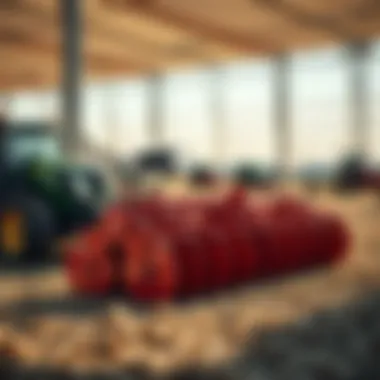

Lessons Learned
Every successful project comes with its share of challenges and learning points. The Missouri farm discovered that not all soil types were conducive to the same depth of operation with the disk.
- Tailoring Depth of Cut: Differentiating depth based on soil types became essential to avoid issues like erosion in sandy soil while maximizing tillage in clay.
The Ohio cooperative learned the importance of timely deployment of the disks. After floods, acting quickly before grass and root systems took hold was critical for effective land recovery.
Furthermore, both cases emphasized the necessity of understanding the mechanical aspects of the implement. Regular maintenance—specifically checking blade sharpness and ensuring all components were functioning—was vital for consistent performance.
In summary, case studies reveal that the Bush Hog disk is more than just a tool; it is a catalyst for improved agricultural practices. Each implementation tells a story of challenges faced and overcome, offering rich insights for others in the agricultural sector. Effective use of these disks not only enhances productivity but also encourages responsible stewardship of farm resources.
"Adapting techniques and technologies to local conditions is the cornerstone of successful farming."
For further reading, consider visiting these resources:
- USDA Agriculture
- University of Illinois Extension
- National Sustainable Agriculture Information Service
By learning from these case studies, it helps shape future practices and innovations in the dynamic world of agriculture.
Comparative Analysis with Other Implements
When farmers and agricultural enthusiasts mull over their choices in field implements, the comparison of tools like the Bush Hog Disk with competitors like plows and graders becomes fundamental. This comparative analysis sheds light on the strengths and weaknesses of each implement, allowing producers to make informed decisions that affect efficiency, productivity, and ultimately, yield.
Comparing these implements isn’t merely an academic exercise; it informs not just purchasing decisions but also operational strategies. Understanding the specific capabilities of each tool helps in adapting them to the unique needs of farming operations, whether it’s for prepping soil, controlling weeds, or managing land more effectively.
Bush Hog Disk vs. Plows
When assessing the Bush Hog Disk against traditional plows, there’s no denying that both serve crucial purposes in agriculture, yet they do so in markedly different ways. Plows are designed mainly for turning the soil, creating furrows that allow for crop planting. They’re a classic choice for many farmers, especially those focusing on conventional farming techniques.
However, the Bush Hog Disk stands out due to its enhanced ability to prepare seedbeds more finely and uniformly. This is essential for crops requiring delicate germination conditions. In essence, while a plow might be putting the soil upside down, a Bush Hog Disk is leveling and smoothing it out.
This functionality offers several benefits:
- Reduced Soil Compaction: Unlike some plows that can compact soil, a disk is designed to slice through the ground, allowing soil to maintain its structure.
- Faster After-Harvest Preparation: The disk can operate more swiftly, reducing the turnaround time between harvest and planting crops for the next cycle.
That said, plows do have their merits, particularly in breaking new ground or dealing with clay-heavy soils. The effectiveness of using either implement depends not just on the type of crop but also on specific soil types and conditions, as well as the existing crop rotation strategy used by the farmer.
"The right tool can make all the difference; understanding when to use a disk versus a plow is a skill every farmer must develop for optimal planting results."
Bush Hog Disk vs. Graders
On the other hand, when putting the Bush Hog Disk side by side with graders, the nature of the comparison shifts to functionality rather than just basic design. Graders are primarily used for leveling surfaces and ensuring adequate drainage on land. They are often deployed for tasks such as maintaining roads or preparing sites for construction.
While graders excel in land leveling, the Bush Hog Disk provides a combination of soil disruption and finely tuned prepping that goes far beyond what a grader can accomplish in terms of preparing soil for crops. The Bush Hog Disk can break up clumps of soil, mixing in organic matter and debris, ensuring a balanced environment for seed germination and plant health.
Key advantages of using a Bush Hog Disk over a grader include:
- Improved Agriculture Yield: The adequate preparation provided by a disk helps in achieving better crop yields, as it supports optimal soil conditions for plants.
- Versatility: The Bush Hog Disk can be adjusted in many ways to handle various tasks that might not be suited for a grader’s more rigid leveling processes.
Economic Impact on Agriculture
The economic impact of the Bush Hog Disk is significant, considering it plays a crucial role in enhancing agricultural productivity. This section dives into how this implement contributes to the bottom line for farmers while also looking at broader economic implications in the agriculture sector. In a world where efficiency and output are vital, understanding the economic aspects of using a Bush Hog Disk can guide decision-making, investment, and future growth in farming.
Cost-Benefit Analysis
When assessing the cost-benefit of utilizing the Bush Hog Disk, several factors come into play. Initially, there are direct costs associated with the purchase and maintenance of the disk itself. Typically, a robust Bush Hog Disk may set a farmer back a few thousand dollars, but the return on investment (ROI) emerges when you consider its long-term benefits. Farmers should consider the following:
- Fuel Efficiency: The design of modern disks enables them to work faster and with less power, which reduces fuel consumption.
- Time Savings: With a Bush Hog Disk, preparing land for planting becomes much quicker, letting farmers utilize their time for other essential tasks.
- Improved Crop Yields: By adequately aerating and processing the soil, the disk contributes to healthier crops, leading to increased yields and, ultimately, greater profit margins.
In a comparative study, farmers who switched to using Bush Hog Disks reported an increase in productivity by up to 20%, showcasing just how pivotal these machines can be.
Investment Returns
The investment returns from purchasing a Bush Hog Disk can be substantial when calculated over several growing seasons. Farmers often observe that while the initial cost might appear daunting, the long-term financial benefits far outweigh these upfront expenses. Here are some key points to consider:
- Reduced Labor Costs: Fewer labor hours are required due to the efficiency of the disk, allowing farmers to allocate resources elsewhere.
- Enhanced Soil Health: A healthy soil structure leads to better crop performance, which often translates into higher profit per acre.
- Increased Versatility: The Bush Hog Disk grapples with various soil types and conditions, ensuring that different farming enterprises can efficiently invest in one versatile implement without needing multiple tools.
In essence, the Bush Hog Disk is not just a piece of equipment—it's an investment in agricultural sustainability and profitability. The economic impact of using this implement extends beyond the individual farmer, influencing market prices and food supply chains as a whole.
"Investing in effective farming equipment like the Bush Hog Disk is not merely an expense; it's a stride towards sustainability and economic viability in agriculture."
For further readings and cost benchmarking, you may refer to University of Minnesota Extension, where aspects of agricultural economics are deliberated extensively.
Environmental Considerations
Understanding the environmental impact of agricultural practices is crucial, especially when discussing implements like the Bush Hog disk. The farmers and land managers wielding this tool must grasp its implications on soil health and erosion control. This section emphasizes the importance of these considerations, highlighting both potential benefits and challenges of using a Bush Hog disk in farming operations.
Impact on Soil Health
Soil health is the cornerstone of sustainable agriculture. It influences crop yield, biodiversity, and overall ecosystem functionality. The Bush Hog disk plays a significant role here:
- Soil Structure Improvement: When properly used, the disk helps in breaking up compacted soil, which is often a hindrance to root penetration. This can promote better aeration and water infiltration, ultimately leading to healthier crops.
- Nutrient Cycling: By incorporating organic material back into the soil, such as crop residues or cover crops, the disk can enhance nutrient availability, fostering a more fertile growing environment.
- Microbial Activity: Disks that are well-maintained and operated judiciously can support a thriving community of soil organisms. These microorganisms are vital for decomposing organic matter and bringing essential nutrients to plants.
Some might argue that aggressive use can lead to issues, like disrupting soil horizons and enhancing erosion. However, by adhering to best practices, negative outcomes can be minimized.
Erosion Prevention Techniques
Erosion is a pressing issue in agricultural areas, often leading to loss of topsoil and decreased productivity. Farmers can adopt several techniques with the Bush Hog disk to help combat this problem:
- Proper Timing: Using the disk at the right time—e.g., before heavy rains or planting—can significantly mitigate erosion risks. Farmers should be aware of their local climate and soil conditions to make informed decisions.
- Strategic Disking Patterns: Implementing specific patterns when operating the disk can help create natural barriers in the field that significantly reduce runoff, thus decreasing the chances of soil erosion.
- Incorporation of Cover Crops: Pairing the usage of a Bush Hog disk with cover crops can protect exposed soil between harvests, as the roots of these crops hold the soil together, preventing erosion.
"It's not just about turning the soil; it's about nurturing what’s beneath it for generations to come."
Ultimately, the careful application of a Bush Hog disk can lead to a symbiotic relationship between agricultural practice and environmental stewardship. Farmers must remain vigilant and educated about the implications of their tools, ensuring that land remains productive without sacrificing long-term health.
For more detailed practices and discussions, visit resources like USDA.gov or NRCS.gov. They offer valuable insights on soil health and conservation methods suitable for farmers.







